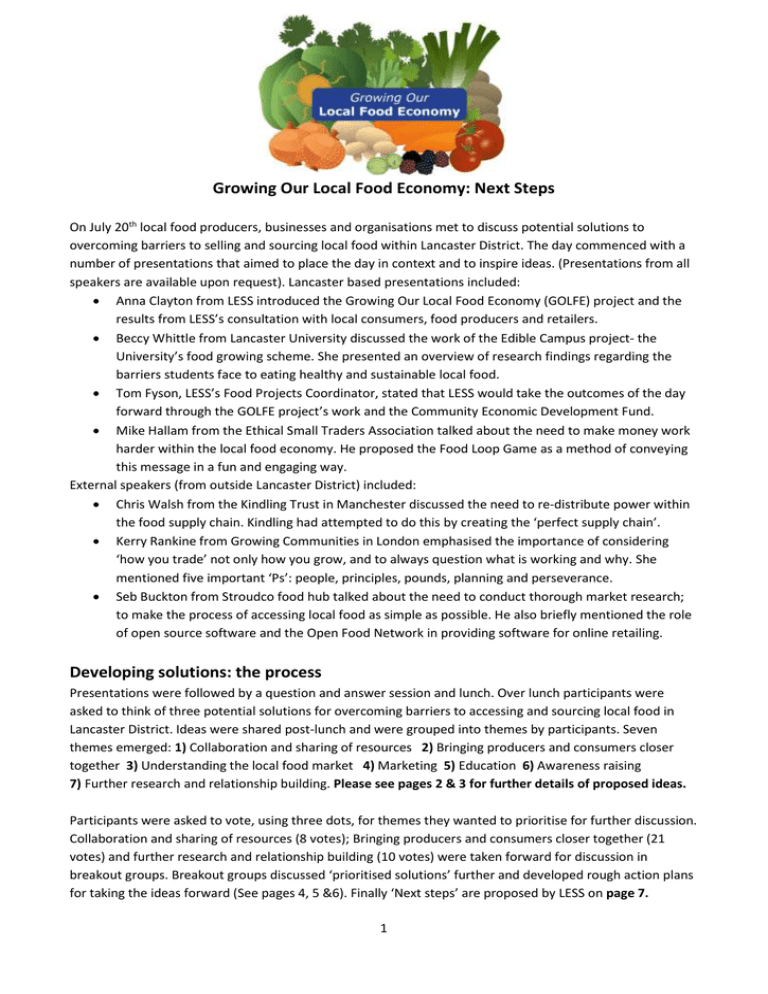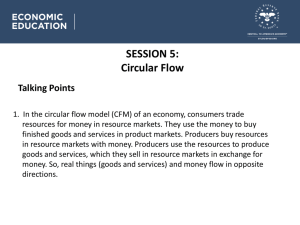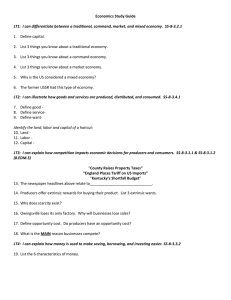GOLFE next steps type up final
advertisement

Growing Our Local Food Economy: Next Steps On July 20th local food producers, businesses and organisations met to discuss potential solutions to overcoming barriers to selling and sourcing local food within Lancaster District. The day commenced with a number of presentations that aimed to place the day in context and to inspire ideas. (Presentations from all speakers are available upon request). Lancaster based presentations included: Anna Clayton from LESS introduced the Growing Our Local Food Economy (GOLFE) project and the results from LESS’s consultation with local consumers, food producers and retailers. Beccy Whittle from Lancaster University discussed the work of the Edible Campus project- the University’s food growing scheme. She presented an overview of research findings regarding the barriers students face to eating healthy and sustainable local food. Tom Fyson, LESS’s Food Projects Coordinator, stated that LESS would take the outcomes of the day forward through the GOLFE project’s work and the Community Economic Development Fund. Mike Hallam from the Ethical Small Traders Association talked about the need to make money work harder within the local food economy. He proposed the Food Loop Game as a method of conveying this message in a fun and engaging way. External speakers (from outside Lancaster District) included: Chris Walsh from the Kindling Trust in Manchester discussed the need to re-distribute power within the food supply chain. Kindling had attempted to do this by creating the ‘perfect supply chain’. Kerry Rankine from Growing Communities in London emphasised the importance of considering ‘how you trade’ not only how you grow, and to always question what is working and why. She mentioned five important ‘Ps’: people, principles, pounds, planning and perseverance. Seb Buckton from Stroudco food hub talked about the need to conduct thorough market research; to make the process of accessing local food as simple as possible. He also briefly mentioned the role of open source software and the Open Food Network in providing software for online retailing. Developing solutions: the process Presentations were followed by a question and answer session and lunch. Over lunch participants were asked to think of three potential solutions for overcoming barriers to accessing and sourcing local food in Lancaster District. Ideas were shared post-lunch and were grouped into themes by participants. Seven themes emerged: 1) Collaboration and sharing of resources 2) Bringing producers and consumers closer together 3) Understanding the local food market 4) Marketing 5) Education 6) Awareness raising 7) Further research and relationship building. Please see pages 2 & 3 for further details of proposed ideas. Participants were asked to vote, using three dots, for themes they wanted to prioritise for further discussion. Collaboration and sharing of resources (8 votes); Bringing producers and consumers closer together (21 votes) and further research and relationship building (10 votes) were taken forward for discussion in breakout groups. Breakout groups discussed ‘prioritised solutions’ further and developed rough action plans for taking the ideas forward (See pages 4, 5 &6). Finally ‘Next steps’ are proposed by LESS on page 7. 1 REMOVING THE BARRIERS TO ACCESSING LOCAL FOOD Ideas discussed further Local food marketing: 6 votes • • Ideas not discussed further Understanding the local food market: 5 votes • • • Talk with customers to understand what their requirements are. How do you build demand quickly enough to make involvement worthwhile for local growers? Need to understand the market for local food- different segment of the population. Local food logo needed for recognition Simple and smart online presence for small producers needed Producers need access to affordable logos/ certification e.g. freedom foods, soil association type groups. Real qualifications and branding of ‘local’ in Lancaster: clear advertisements e.g. suggest logo or similar. Or ‘Lancaster salad’... Promotion of ‘local’ through shared marketing An online presence for farmers and producers. Perhaps educate producers about online media and importance of having an online presence (and Food Assembly etc). A lot of online media seems pointless but young families are using it to save time and money. Lancashire taking ownership of amazing local producers and advertising through council, NHS and other larger organisations with big advertising budgets. • • • • • Bringing producers & consumers closer together: 21 votes • • • • • • • • • • • • • • • • • • • • Flexibility of delivery for producers/ growers (don’t just think about flexibility for consumer) Could schools be distributors or sellers? Co-operate with existing outlets (fishmonger, butcher, deli etc) to promote locally sourced produce A hub for delivering food too. Box schemes in Lancaster should consider central drop off points Local food collection points in every neighbourhood A van that collects produce and then brokers at market stalls Shared market stall Old fashioned travelling or mobile food store or coop A joint market stall Vegetable shop seems like a good idea for a wider and new market. Shouldn’t worry about competition. Aim would be people who don’t access veg boxes or single step vegetables. Delivery scheme that offers wide range of food (veg, meat, cheese, bread, eggs, store cupboard) Cooperative online platform for producers to sell products online directly to consumers Get local food into small convenience stores Create a Lancaster Food Co of suppliers and consumers. It should act as a focal point for all the initiatives that currently exist; it should fill the gaps and help any struggling projects. Also outlets on the borders- all work should not necessarily focus on Lancaster. Make sure can source rurally as well! Proper farmers market in Lancaster Out of hour’s access. Many people can’t access food in 9-5 working hours Link in with existing infrastructure, businesses , schools etc Drop off points at food hub sites out of 9-5 working hours (needs to be flexible). 2 REMOVING THE BARRIERS TO ACCESSING LOCAL FOOD Ideas discussed further Further research & relationship building: 10 votes • • • • • • Encourage producers and retailers to collaborate by providing some sort of forum Encourage more retailers to participate. Go back to local retailers and find out why they didn’t respond to survey. This research needs more work. Make the money already in the local food economy work harder. Producer, retailer speed dating Identify which shops and producers exist and are interested in growing our local food economy. Identify current gaps (what not being produced, what not currently available locally). This could provide an opportunity for new producers and small community coops to supply etc Start with existing food providers first rather than starting anew. Ideas not discussed further Collaboration & sharing of resources: 8 votes • • • • • Education: 5 votes • • • Disco soup Seasonal taster events Re-education about food through generations. School children to grandparents. Plant based meals- cookery courses, recipe sharing, encourage other restaurants and cafés to offer more vegetarian and vegan options. Education of next generation and consumers new to the idea of sustainable food. Often promotion only reaches those that are already in the know: preaching to the converted. • • • • • • • Awareness-raising: 0 votes • For the public need clarification of the words used to describe products e.g. what does ‘local’, ‘environmental,’ ‘animal welfare,’ and ‘farm GROUPING ONE: Collaboration and sharing of resources shop’ really mean? 8 votes 3 Land army. Work with CVS centre (?) to create a bank of volunteers that can support local farms and community projects. Resource sharing: equipment, skills, vehicles etc. Can job centres provide workers as part of work experience placements for job seekers under new rules? I like the idea of ‘micro farms’ (like in Hackney) and tapping into really small scale producers who may already be producing but have no current outlet or no business experience. Identify latent core of would-be producers: those who would like to work in the local food sector but can’t find an entry point e.g. access to land & training. Link into networks: Sustainable Food Cities and Soil Association’s Food For Life. Get the university and other public sector bodies to spend 1% on local food. Can schools be engaged as growers/producers? Local food hub: training opportunities, equipment available for hire (kitchen etc), space that support’s new small scale producers. Collaborate across all sectors. Work with the ‘best’ of the public sector, private sector and community sector in order to allow for ongoing personal, collaborative learning and training. ACTION PLANS about how they can make their businesses better. GROUPING ONE: Collaboration and sharing of resources We need to create an online hub. It should make facilities and opportunities available to loan and share resources (online brokerage). It could also be used to provide volunteer opportunities. Aspirations: a living wage; allow people to step into employment opportunities through job centre; people in recovery engaged in growing. Participants: Tom Fyson, Kate Rowley, Mike Hallam, Sharon Peacock, Seb Buckton, Jane Attfield, Beccy Whittle, Joanne Halliwell Key questions: Wider research needed: How has this worked elsewhere? (Five Penny Farm: Peasant Evolution Producers Co-operative.) What insurance and hygiene regulations etc required? What resources are needed and what are currently available? (eg slicer, vac pack, kitchens) Would a coop be a suitable model for buying/ owning equipment to share? What payment mechanisms would be suitable: cash/ in kind? How can this link in with Stroud Co. and the wider Open Food Network? Key actions: Investigate the Open Food Network Hackathon? Develop links with the university to produce suitable software or develop existing models Contact and learn about Five Penny Farm: Peasant Evolution Producers Co-operative. Research other models e.g.coop lending equipment LESS and CVS to meet to discuss volunteer opportunities. Volunteer roles for admin, delivery, transport etc within the local food economy. 4 GROUPING TWO: Further research and relationship building We need to map the current local food economy to build on LESS’s consultation work. We need to identify gaps and utilise current infrastructure, skills and experience, whilst fostering relationships. Participants: Kerry Rankine, Steph Stephenson, Liz Hayes, Anna Clayton Key Questions: Why are some retailers and producers currently not engaging? What do businesses want and need? And how can GOLFE support these needs? How should GOLFE best work with a bunch of very busy people and bring them together? How do we foster an environment of collaboration? Key actions: LESS should map the current local food economy and note characteristics of businesses (Needs and Wants? How well established? Family business? Young professionals? Interested in GOLFE? What sell and offer?). Emphasise listening over talking! This work should be ongoing and should be made fun! LESS should use creative actions to involve the wider community in food mapping work - to build relationships and community support. For example: spot the milkman! Who delivers in your area? Build on current contacts to help build local food economy map Host regular events that encourage local food producers and businesses to meet in a fun and relaxed atmosphere. (To create trust and friendships). This could take the form of speed dating and taster evenings (promotion) etc. Evenings were suggested as a best time of day to host these events. Re-do retailer research. Emphasise face-to-face meetings. Ask what businesses want first. What could help businesses improve? Make it clear who can get involved. If using questionnaires make them clear and short as time is very valuable. Make clear the benefits and expectations of participating from the start. Emphasise a hierarchy of steps to make process inclusive. Buying local food from a supermarket > buying from an independent local retailer> buying locally produced food from an independent retailer> buying local and sustainable food from a local independent retailer. IT’S A JOURNEY. If running targeted events or periods of focused discussion and promotion think about the seasons. January was suggested as a good time of year for working with local food businesses. New Year’s resolutions could be used as a hook to get businesses on board- making them think about how they can make their businesses better. 5 GROUPING THREE: Bringing producers and consumers closer together Participants: Desna Mackenzie, Chris Walsh, Rod Everett, Steve Jenkins, Liz Hickingbotham, Chris Stephenson, Rebecca Dobson. IDEA ONE: Encourage more local convenience stores to stock local food (and cafés and restaurants?) Key Questions: How prove safety of food/ that it comes from a recognised source. ‘Accreditation’ - kite mark? What are the volume and delivery requirements for convenience stores? Advocate for a collective of local producers. ‘Point of sale’ shelf, signage etc. Trading first, branding later? Actions: LESS to scope answers to volume and delivery requirements of convenience stores; options for proving safety and quality of food; methods of selling to convenience stores. Establish steering group for producer collective IDEA TWO: Shared Market Stall (to prove product). Key Questions: What is the potential role of a market stall? How do you create the space for collective working? Actions: Market stalls are not economically viable but are great for showcasing produce to potential customers. A stall can be used for market research and to convince retailers to participate. Utilise existing delivery routes for picking up and dropping off produce for market stall. Need a key personality on stall Convene a collective- who should be in it? Governance structure needs to be thought throughproducers need to have ownership but don’t have to put time into delivering it. Transparency is crucial. OUTCOME: ESTABLISH A PRODUCER COLLECTIVE Key Questions: Who delivers the work and who is the advocate? Clarity about needs of buyers and sellers etc Buyers need to be present. Actions: Create a steering group for producers. Producers and LESS staff should be involved. First meeting could take place after 2nd august on a Tuesday, Wednesdays or Thursday. 6 WHAT’S NEXT? The action plans developed for ‘further research and relationship building’, ‘bringing producers closer together’ and ‘collaboration and sharing of resources’ will be taken forward, with LESS acting as a key facilitator. The order in which these are taken forward is open for discussion and will depend on the feedback we get from local food businesses and Andrew Suter- our Community Economic Development Fund advisor. In addition, ideas that were not prioritised on the day will not be lost. We have documented them and will share them with other local groups. We will also try to incorporate them into our future plans. If you have any thoughts about the event or the outcomes, please share them with us. Even if you could not attend the conference it would be great to have your thoughts and comments. Also, if you are interested in supporting any of the outputs in specific, please let us know. We will keep in touch regarding any developments, meetings and events. In the meantime, you can contact us! Address: LESS, The Storey, Meeting House Lane, Lancaster, LA1 1TH Email: food@lessuk.org Phone number: 01524 66100 Website: www.lessuk.org Facebook page: Growing Our Local Food Economy – GOLFE Lancaster 7






